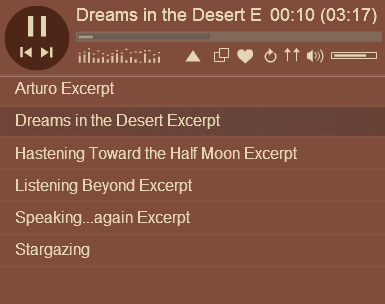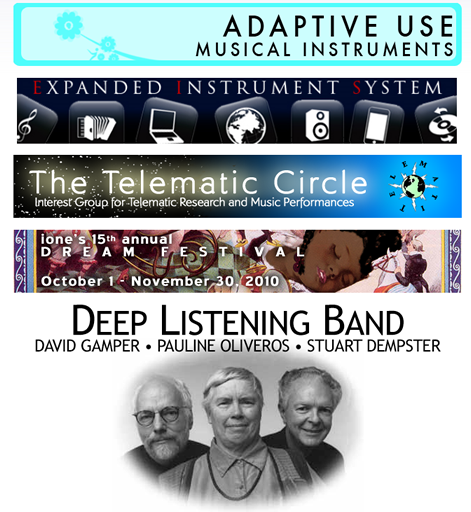 |
With the explosion of audio technology, at any one moment you can listen to your favorite band on an iPod, video chat on Skype, tune out typical office buzz, watch a singing cat on YouTube, and talk with a friend on Bluetooth. With dozens of sound sources striking your ears at any one moment, how can you train your ears to listen and not just hear (and ignore) sounds? How can you filter out the unimportant noise in your life and focus on truly listening to what matters? |
“We know more about hearing than listening.” – Pauline Oliveros
Legendary composer Pauline Oliveros developed the concept of Deep Listening as a unique way to develop the ear in relation to actively listening to sound and not just hearing. Deep Listening fosters creativity in the arts and technology by cultivating improvisation and an “appreciation of sounds on a heightened level.”[1]
In other words, by training your ears and mind to actively listen to sounds, instead of tuning them out, you will enjoy an increased level of audio understanding, deeper levels of creativity, and connectivity with your environment.
In between concerts Pauline Oliveros took the time to share her insight about Deep Listening with Easy Ear Training:
“Deep Listening explores the difference between hearing and listening. Though we receive sound waves through the ears these waves are transduced to electrical impulses by the mechanisms of the ear and transmitted to the brain where listening takes place. The ear does not listen – the brain listens.
Listening is a lifetime practice that depends on accumulated experiences with sound. Listening can be focused to detail or open to the entire field of sound. Listening still is a mysterious process that is not the same for everyone although we have consensual agreements on the interpretation of sound waves delivered to the brain by the ears. We know more about hearing than listening.”– Pauline Oliveros, Deep Listening institute
1) Solo Exploration by Pauline Oliveros
Adapted from the Deep Listening Study Group Portal Exercises by Pauline Oliveros, published under “Sounding the Margins”. [2]
Take a moment, in your home or office or even right now, and close your eyes.
Listen.
Think of each noise, sound, voice, and note as music.
Open your eyes and think about what you heard.
Remember, and then express the music with your voice or an instrument.
2) “Dreams in the Desert” by composer Elainie Lillios
Hundreds of artists, poets, and musicians throughout the decades have actively involved themselves in the practice of Deep Listening. Their music often reflects a unique combination of new music and sound art. You can find a complete list of Deep Listening Artists here.
Close your eyes and listen to the electronic work “Dreams in the Desert‘ by composer Elainie Lillios.
What sounds do you hear? Where does the work take you? Are the sounds real or imagined? Can you make these sounds? Try to recreate the sounds from “Dreams in the Desert”.
3) Soundwalk by Pauline Oliveros
Adapted from the Deep Listening Study Group Portal Exercises by Pauline Oliveros, published under “Sounding the Margins”. [2]
In a group or alone, silently walk in your environment. This can be a natural environment, the city, or your local neighborhood. As you walk, expose your ears to each and every sound. Share your listening experience.
Here are some great resources and listening exercises by the Deep Listening Institute:
- Deep Listening Study Group Portal .Designed to encourage Deep Listening, the Deep Listening Study Group Portal provides several listening exercises and text scores by Pauline Oliveros. These exercises can be practiced by anyone – musicians, educators, music lovers, or just people interested in developing the skill of listening.
- Deep Listening Institute . Founded by Oliveros, the Deep Listening Institute provides a variety of online and in person music, interdisciplinary, and improvisation workshops and classes. The site has resources for musicians interested in the latest interactive music technology systems like the EIS system (Expanded Instrument System) and the Telematic Circle (internet global performance via video chat), as well as the more philosophical Dream Festival.
Musicians find that mastering Deep Listening provides a new appreciation for sound, music, and creativity. Improvisation skills improve significantly as your brain actively engages in music and sound. Increased awareness leads to better performance and higher levels of overall musicianship. Artists who want to explore Deep Listening can enjoy the amazing online community and creative collaborations that the Deep Listening Institute affords. Even casual music enthusiasts find Deep Listening an enjoyable and innovative way to experience music and sound.
Share your own Deep Listening experiences with us in the comments below. We want to know how Deep Listening has changed your life!
Show article sources
Sources
- Deep Listening Institute. (2011). Deep Listening Institute. Retrieved from http://deeplistening.org/site/content/about
- Deep Listening Institute. (2011). Deep Listening Study Group Portal. Retrieved from https://ecampus.phoenix.edu/secure/aapd/cwe/citation_generator/web_01_01.asp









